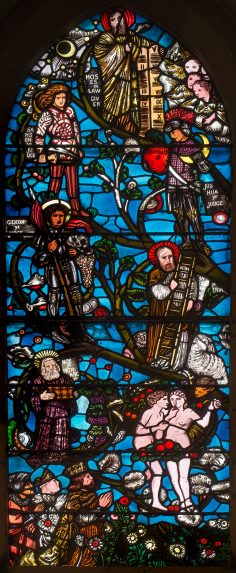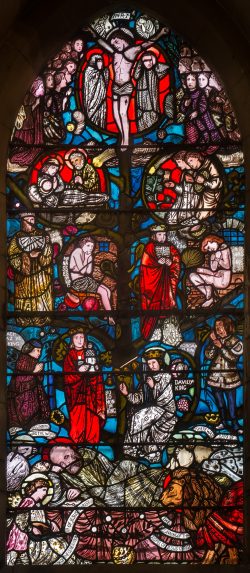The Abbey Church, Waltham Abbey, Essex
Address
Waltham Abbey Church, 4 Church Street, Waltham Abbey, Essex EN9 1DJRecommended by
Highlight
East window - Three lancets and roseArtist, maker and date
Designed by Edward Burne-Jones and made by James Powell and Sons, 1860-61Reason for highlighting
These were the last stained-glass windows designed by Edward Burne-Jones during his brief tenure as chief designer of James Powell and Sons, and soon afterwards he joined William Morris et al. The glass here is not in the pre-Raphaelite or Aesthetic styles of his later work with Morris, but of more a vigorous design that looks surprisingly modern. The three lancets depict a Tree of Jesse while the rose above includes Christ in Majesty along with The Seven Days of Creation.
Burne-Jones’ successor as Powell’s chief designer was his pupil Henry Holliday who designed the single window to the south of the east window, 1867. This too is an early work of Holliday’s before he fully embraced the Aesthetic movement and deserves comparison with his master’s work.
Artist/maker notes
Sir Edward Coley Burne-Jones (1833-1898) was born in Birmingham and studied at Exeter College, Oxford where he met William Morris, with whom he developed a lifelong friendship. Together they created hundreds of stained glass windows that collectively stand as one of the finest artistic achievements of their time. The stature of this formidable artist and designer was recognised after his death when he became the first artist to be given a Memorial Service at Westminster Abbey.
Sources:
Burne-Jones Special Issue, The Journal of Stained Glass, Vol. XXXV, 2011
The Last Pre-Raphaelite: Edward Burne-Jones and the Victorian Imagination by Fiona McCarthy (Faber & Faber, 2011).
James Powell & Sons was formed when James Powell purchased Whitefriars Glass, an old established glass works, in 1834. His sons developed the business to be one of the major firms of the Victorian and Edwardian eras. Especially notable is their work with Charles Winston in the 1840s and 1850s to improve the quality of glass available, and the many fine designers with whom they worked. The company’s innovations extended beyond stained glass, with the company developing a formidable reputation in a number of fields, including tableware glass, where Whitefriars Glass remains highly collectable. The stained glass department finally closed in 1973, and the company in 1980.
Sources:
James Powell & Sons, Whitefriars by Jacqueline Banerjee, PhD, Associate Editor, The Victorian Web
Victorian & Edwardian Stained Glass by Marta Galicki (Historic England, reprinted by Morris & Juliet Venables, 2001)


